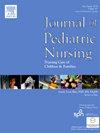Measurement tools for assessing nausea, vomiting, and retching in pediatric populations: A scoping review
IF 2.3
4区 医学
Q2 NURSING
Journal of Pediatric Nursing-Nursing Care of Children & Families
Pub Date : 2025-09-26
DOI:10.1016/j.pedn.2025.09.019
引用次数: 0
Abstract
Background
Nausea, vomiting, and retching are distressing symptoms in pediatric patients, yet their assessment remains inconsistent due to a lack of standardized, age-appropriate tools aligned with children's developmental needs.
Aim
This scoping review aimed to identify, map, and evaluate the tools currently used to measure nausea, vomiting, and retching in pediatric populations, specifically focusing on their psychometric properties, applicability, and limitations in clinical and research settings.
Method
The review followed the PRISMA-ScR and Joanna Briggs Institute guidelines. A comprehensive search was conducted across six databases (PubMed, Web of Science, Cochrane Library, MEDLINE, CINAHL, and Scopus) up to January 2025.
Results
A total of 14 studies met the inclusion criteria, covering 14 measurement tools. Most tools (n = 14) were developed for self-report use, while 10 incorporated proxy-report methods. Tools varied in their focus, with several designed for oncology settings (e.g., BARF Scale, PeNAT, NVTS, SSPedi), while others addressed gastrointestinal disorders, chronic kidney disease, or brain tumors. Outcomes assessed included nausea intensity, vomiting, retching, pain, dietary intake, functional impairment, and emotional symptoms.
Practice implications
Existing tools provide useful insights into pediatric nausea and vomiting but differ widely in design and applicability. Standardized, age-appropriate, and culturally adaptable tools are urgently needed for accurate assessment in pediatric patients.
Conclusion
Most tools demonstrated acceptable reliability and validity; limited sensitivity for younger children, proxy-report variability, and cultural adaptation were noted. Current tools offer valuable insights into pediatric nausea and vomiting but vary significantly in design, scope, and applicability.
评估儿科人群恶心、呕吐和干呕的测量工具:范围综述
恶心、呕吐和干呕是儿科患者的痛苦症状,但由于缺乏符合儿童发育需要的标准化、适合年龄的工具,对这些症状的评估仍然不一致。目的:本综述旨在识别、绘制和评估目前用于儿科人群恶心、呕吐和干呕测量的工具,特别关注其心理测量特性、适用性和在临床和研究环境中的局限性。方法本综述遵循PRISMA-ScR和Joanna Briggs Institute的指南。到2025年1月,对六个数据库(PubMed、Web of Science、Cochrane Library、MEDLINE、CINAHL和Scopus)进行了全面的检索。结果共有14项研究符合纳入标准,涵盖14种测量工具。大多数工具(n = 14)用于自我报告,而10个纳入代理报告方法。工具的重点各不相同,有几个是为肿瘤学环境设计的(例如,BARF量表、PeNAT、NVTS、SSPedi),而其他工具则针对胃肠道疾病、慢性肾脏疾病或脑肿瘤。评估的结局包括恶心强度、呕吐、干呕、疼痛、饮食摄入、功能损害和情绪症状。现有的工具为儿科恶心和呕吐提供了有用的见解,但在设计和适用性方面存在很大差异。迫切需要标准化、适合年龄和文化适应性的工具来对儿科患者进行准确评估。结论大多数工具具有可接受的信度和效度;注意到对年幼儿童的敏感性有限,代理报告的可变性和文化适应。目前的工具为儿科恶心和呕吐提供了有价值的见解,但在设计、范围和适用性方面差异很大。
本文章由计算机程序翻译,如有差异,请以英文原文为准。
求助全文
约1分钟内获得全文
求助全文
来源期刊

Journal of Pediatric Nursing-Nursing Care of Children & Families
NURSING-PEDIATRICS
CiteScore
3.70
自引率
8.30%
发文量
291
审稿时长
65 days
期刊介绍:
Official Journal of the Society of Pediatric Nurses and the Pediatric Endocrinology Nursing Society (PENS)
The Journal of Pediatric Nursing: Nursing Care of Children and Families (JPN) is interested in publishing evidence-based practice, quality improvement, theory, and research papers on a variety of topics from US and international authors. JPN is the official journal of the Society of Pediatric Nurses and the Pediatric Endocrinology Nursing Society. Cecily L. Betz, PhD, RN, FAAN is the Founder and Editor in Chief.
Journal content covers the life span from birth to adolescence. Submissions should be pertinent to the nursing care needs of healthy and ill infants, children, and adolescents, addressing their biopsychosocial needs. JPN also features the following regular columns for which authors may submit brief papers: Hot Topics and Technology.
 求助内容:
求助内容: 应助结果提醒方式:
应助结果提醒方式:


